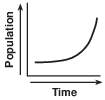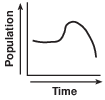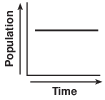Topic: Human Influences On Global Stabilities Of Ecosystems
Human Influences On Global Stabilities Of Ecosystems
Human population growth has led to a reduction in the populations of predators throughout natural ecosystems across the United States. Scientists consider the loss of these predators to have a
(1) positive effect, because an increase in their prey helps to maintain stability in the ecosystem
(2) positive effect, because predators usually eliminate the species they prey on
(3) negative effect, since predators have always made up a large portion of our food supply
(4) negative effect, because predators have an important role in maintaining stable ecosystems
Which human activity would interfere most directly with the production of oxygen in the environment?
(1) using fertilizer for agriculture
(2) using nuclear fuels
(3) accelerating deforestation
(4) preserving wetlands
Environmentalists are hoping to protect endangered organisms by calling for a reduction in the use of pesticides, because loss of these organisms would
(1) increase the mutation rate in plants
(2) cause pesticides to become more toxic to insects
(3) reduce biodiversity in various ecosystems
(4) decrease the space and resources available to other organisms
Which farming practice causes the least harm to the environment?
(1) using natural predators to reduce insect numbers
(2) adding chemical fertilizers to all the crops in the area
(3) planting the same crop for 1 year on all the fields in the area
(4) planting the same crop in the same field each year for 10 years
Which action by humans could improve the quality of the air?
(1) building homes that use only oil furnaces for heat
(2) buying cars that get more miles per gallon of gasoline
(3) increasing the number of coal-burning power plants that generate electricity
(4) cutting down forests to clear land for factories
Increased human population growth usually results in
(1) a decrease in the need for farming
(2) a need for stronger environmental protection laws
(3) lower levels of air and water pollution
(4) an increase in natural wildlife habitats
In 2003, the city of Rochester, New York, began killing weeds with steam. A machine heats water to 280°F then sprays it on the weeds with great pressure. The extreme heat destroys the cellular structure of the plants. What is a possible disadvantage of this method of weed control?
(1) It can be used safely in areas where children play.
(2) It reduces the number of mutations in the ecosystem.
(3) It destroys weeds without chemicals.
(4) It alters the habitats of some beneficial insects.
Which graph best illustrates the change in the human population over the past 2000 years?
(1) 
(2) 
(3) 
(4) 
In New York State, cars are inspected to be sure they are not releasing excessive amounts of several gases into the atmosphere. This is done in an effort to
(1) recycle more nutrients
(2) reduce biodiversity
(3) reduce global warming
(4) increase the growth rates of forests
Certain animal species that are endangered or threatened have been cloned. Closely related species have been used to carry the embryos of the endangered species. This process of increasing the population size of a species in danger of becoming extinct is an example of a
(1) natural method to decrease ecosystem stability
(2) natural method of controlling the population of an endangered species
(3) technological fix to increase habitat destruction
(4) technological fix for the problem of endangered species
Car manufacturers have begun to explore the use of biofuels, such as biodiesel, ethanol, and cooking oils made from plant material. The desired outcome of using these biofuels would be
(1) a decrease in the use of fossil fuels
(2) a decrease in the release of oxygen gas
(3) an increase in abiotic resources
(4) an increase in global warming
Decline in the Amphibians
Declines in amphibian species, such as frogs, toads and salamanders, might affect the ways in which ecosystems function. Amphibians prey on many types of small organisms that survive by consuming leaf litter (leaf material on the ground of ecosystems). These small organisms include animals such as earthworms, centipedes, millipedes, pill bugs, and many species of insects. In turn, amphibians are preyed on by fish, herons, chipmunks, turkeys, foxes, coyotes, and other animals.
Human activities often cause a reduction in the size of amphibian populations. As amphibian populations are reduced, the organisms that are preyed on by amphibians increase in number. As the populations of small forest organisms increase, the amount of leaf litter decreases. The decrease in the amount of leaf litter on the forest floor may have negative effects on the forest ecosystem.
Identify one human activity and describe how that activity could directly or indirectly lead to a reduction in amphibian populations. [1]
Allow 1 credit. Acceptable responses include, but are not limited to:
• — Building in the area destroys the habitat.
• — Deforestation reduces the area where animals can find food and shelter.
• — Burning fossil fuels leads to acid rain, resulting in the death of organisms.
• — Introducing nonnative species increases competition for resources and could cause the loss
• of an organism to an area.
• Note: Allow credit for a human activity, not the product of activities, not just “pollution” without
• an explanation.
At an observatory in Mauna Loa, Hawaii, scientists have been measuring and collecting data related to changes in the atmosphere since the 1950s. The remote location of the observatory makes it ideal for studying atmospheric conditions that can cause climate change. One specific measurement taken is the amount of atmospheric carbon dioxide. Information for a 7-year period is shown in the graph below.

Analyze the data shown in the graph. In your answer, be sure to:
• state the overall relationship between time and carbon dioxide levels [1]
• state one possible cause for the overall change in the carbon dioxide levels shown in the graph [1]
• identify the biological process that might account for the decreases in carbon dioxide levels [1]
• identify two actions carried out by humans that could lower carbon dioxide levels [1]
The student’s response to the bulleted items in the question need not appear in the following order.
• 13 Allow 1 credit for stating the overall relationship between time and carbon dioxide levels.
• Acceptable responses include, but are not limited to:
• — As time increased, the levels of carbon dioxide increased.
• — As time went by, the amount of carbon dioxide increased.
• — Carbon dioxide production fluctuated with the seasons.
• 14 Allow 1 credit for stating one possible cause for the overall change in the carbon dioxide levels
• shown in the graph. Acceptable responses include, but are not limited to:
• — increase in human population
• — fewer photosynthetic organisms
• — deforestation
• — increased use of fossil fuels
• — increased volcanic activity
• Note: Do not accept just “pollution” without a source or explanation.
• 15 Allow 1 credit for identifying the biological process that might account for the decreases in carbon
• dioxide levels. Acceptable responses include, but are not limited to:
• — photosynthesis
• — autotrophic nutrition
• 16 Allow 1 credit for identifying two actions carried out by humans that could lower carbon dioxide
• levels. Acceptable responses include, but are not limited to:
• — planting more trees
• — reducing the use of fossil fuels
• — car pool/use public transportation/reduce driving
• — recycling
• — using alternative energy sources
Mosquito Technologies of New York, Inc., has developed a Mosquito Killing System (MKS) to help control the mosquito population and reduce the transmission of West Nile Virus. The MKS works by taking advantage of the natural hunting strategies of mosquitoes, such as heat sensing and carbon dioxide detection. Beneficial insects do not use the same hunting strategies. The MKS unit produces heat and releases carbon dioxide in cycles, mimicking the breathing and body temperatures of humans, pets, and other warm-blooded animals. This attracts the mosquitoes to the device and, once inside, a vacuum pulls them in, where they pass through an electrocution grid, killing them. The mosquito remains are then returned to the environment through the bottom of the unit.
The unit contains a solar-powered photocell that turns the device on at dusk and turns it off at dawn.
State one positive effect the use of this MKS device has on the environment. [1]
Allow 1 credit. Acceptable responses include, but are not limited to:
• — It doesn’t use or produce any harmful chemicals.
• — Mosquito remains are returned to the environment.
• — It does not harm beneficial insects.
• — It reduces the transmission of Wet Nile virus.
Gray Wolves in the Rocky Mountains
Reintroduction of gray wolves in the northern Rocky Mountains has increased the ecological health of Yellowstone National Park in Wyoming. When all wolves in Yellowstone National Park were killed in 1920, elk soon ate trees and shrubs down to short stubs. Now that wolves are reducing elk numbers, many aspens and willow trees are taller and fuller and birds are returning to the trees to nest. The beaver population has grown from one colony to 12 colonies in 13 years. Spreading these benefits across the Rocky Mountain region would require increasing the present wolf population of 1,770 to 17,000.
In September 2012, wolves lost federal protection in Wyoming. In 2014, Wyoming closed its hunting season after meeting its quota of 26 wolves around Yellowstone and Grand Teton parks. The sizes of traps to catch wolves have been regulated to reduce the chance of trapping endangered species such as lynx and wolverines and the hunting season was shortened. Some ecologists wonder if removing the wolves from federal protection and allowing them to be hunted is a good ecological decision.
Explain how increasing the wolf population caused an increase in birds and beavers. [1]
Allow 1 credit. Acceptable responses include, but are not limited to:
• — Wolves ate the elk that fed on the trees. The trees supply shelter for birds and food for
• beavers.
• — An increase in wolves resulted in more trees growing for birds/beavers to use.
